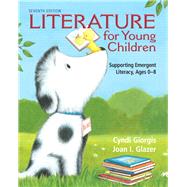
Cyndi Giorgis is a Professor of Children’s Literature at the University of Nevada Las Vegas where she teaches courses in children’s literature, visual literacy, multicultural literature, and literature for young children. She is a former primary grade classroom teacher and school librarian. She has served on the Newbery, Caldecott, and Geisel Award committees and is a former editor of The Reading Teacher’s Children’s Book Review column. Professor Giorgis has edited the Journal of Children’s Literature and has served on various boards such as the International Reading Teacher’s Special Interest Group in Children’s Literature and Reading and the board of the Children’s Literature Assembly. Dr. Giorgis has published numerous professional articles about literature in the classroom including the most recent book chapter in A Master Class in Children’s Literature: Trends and Issues in an Evolving Field as well as the book The Wonder of It All: When Literature and Literacy Intersect. She is the recipient of the International Reading Association’s Arbuthnot Award for Outstanding Professor of Children’s and Young Adult Literature.
Joan I. Glazer is Professor Emerita of Education at Rhode Island College, where she taught courses in children’s literature, language arts, and reading. She has taught at the elementary school level, served as a Head Start supervisor, and worked as an educational consultant for numerous school districts. She spent the 2002–2003 academic year in Norway as a Fulbright Scholar, visiting more than 60 schools to present teacher workshops and demonstration lessons focusing on American Studies. She is a past president of the United States Board on Books for Young People, a past Executive Committee member of the International Board on Books for Young People, and is the current president of the board that oversees the publication of Bookbird: A Journal of International Children’s Literature. Dr. Glazer has been honored with the Distinguished Teacher Award from the Feinstein School of Education and Human Development at Rhode Island College, was the first holder of the Thorp Professorship for Scholarship, and has received the school’s Award for Service.
1 Defining Literature for Young Children
The Range of Literature
Format
Literature-Based Media
Genre
Children’s Preferences in Literature
Children and the Literary Experience
Helping Parents Select Literature
Summary
2 Evaluating Literature for Children
Evaluating Fiction
Literary Elements
Coherence
Integrity
Evaluating Nonfiction
Organization
Accurate Presentation of Facts
Current Information
Evaluating Poetry
Evaluating Illustrations
Proximity to Text
Developing the Text
Capturing the Emotional Link
Appropriateness of Illustrations
Evaluating Interactive Literature on CD-ROM
Summary
3 Sharing Literature
Reading Aloud
Finding the Right Book
Creating a Positive Environment
Helping Children Construct Meaning
Storytelling
Finding the Right Story
Creating a Positive Environment
Helping Children Construct Meaning
Sharing Literature Through Media
Finding the Right Media
Creating a Positive Environment
Helping Children Construct Meaning
Helping Others Share Literature
Summary
4 The Literature Curriculum
Developing the Imagination
Promoting Positive Attitudes
Regular Sharing of Literature
Literature Selection
Strategies and Activities for Responding to Books
Grouping Books for Instruction
Book Comparisons
Units of Study
Webs
Using Literature Across the Curriculum
Summary
5 Planning Your Program
Seeing the Possibilities
A Book for Toddlers and Preschoolers
A Book for Primary Grades
Selecting Activities
Recognizing the Larger Context
The Literature Curriculum
The Child’s World
Evaluating Your Literature Program
6 Supporting Children’s Language Development
Language Development in Young Children
How Children Learn Language
How Children Become Literate
The Need to Hear Rich Language
The Need to Use Language
Goals for Teaching
Opportunities Books Offer
Exposing Children to Mature Language
Introducing New Vocabulary in Context
Encouraging Language Play and Demonstrating How Others Have Used Language Creatively
Playing with the Patterns of Language
Exploring Other Languages
Giving Children Practice in Attentive, Critical, and Appreciative Listening Skills
Leading Naturally into Reading Encouraging Children to Respond to Books Orally
Engaging Children in a Variety of Writing Activities
Building Ideas from Types of Writing
Incorporating Visual Literacy
Summary
7 Supporting Children’s Intellectual Development
Intellectual Development in Young Children
Goals for Teaching
Opportunities Books Offer
Assisting in the Acquisition and Refinement of Concepts
Developing Skill in a Variety of Thinking Processes
Expanding the Ability to Reason Logically
Encouraging Critical Thinking
Engaging in Problem Solving
Summary
8 Supporting Children’s Personality Development
Personality Development in Young Children
Goals for Teaching
Opportunities Books Offer
Involving Children in Making Choices
Encouraging Children to Set and Complete Tasks
Building Self-Concept
Developing Sex-Role Expectations
Building Self-Esteem
Recognizing One’s Own Values
Summary
9 Supporting Children’s Social and Moral Development
Social and Moral Development in Young Children
Social Development
Moral Development
Goals for Teaching
Opportunities Books Offer
Giving Children Experience in Making Inferences About the Feelings and Intentions of Others
Fostering Children’s Ability to See from the Viewpoint of Others
Providing Models of Prosocial Behavior
Encouraging Children to Judge the Appropriateness of Particular Behaviors
Helping Children Learn About and Value Differences Among People
Stimulating Children to Explore Moral Problems and Ethical Questions
Summary
10 Supporting Children’s Aesthetic and Creative Development
Aesthetic and Creative Development in Young Children
Creative Potential
Development in Art
Development in Music
Goals for Teaching
Opportunities Books Offer
Introducing Children to Diverse Styles of Art
Sharpening Children’s Awareness
Giving Children Experience with a Variety of Art Media
Giving Children a Variety of Musical Experiences
Stimulating Creativity in Art, Music, and Movement
Making Aesthetic and Creative Experiences Enjoyable for Children
Summary
Appendix
Author/Illustrator/Title Index
Subject Index
The New copy of this book will include any supplemental materials advertised. Please check the title of the book to determine if it should include any access cards, study guides, lab manuals, CDs, etc.
The Used, Rental and eBook copies of this book are not guaranteed to include any supplemental materials. Typically, only the book itself is included. This is true even if the title states it includes any access cards, study guides, lab manuals, CDs, etc.